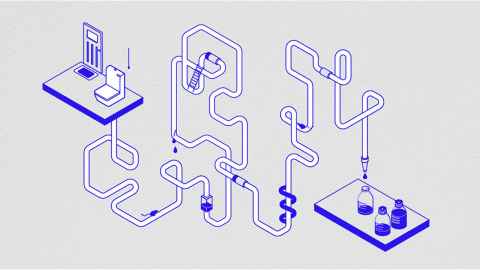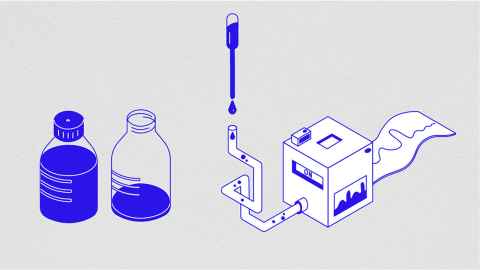Every flush a donation to science
9 April 2024
You probably don’t give a second thought to what you flush down the toilet. But wastewater and all that it contains provides valuable knowledge to researchers working in wastewater-based epidemiology.

A collaboration between analytical chemist Lisa Pilkington and illustrator Jean Donaldson. Edited by Anna Brown and Jonathan Burgess.
Wastewater is everything you put down the drain – including number ones and number twos. Every time you rinse something down the sink, wash your clothes, have a shower or go to the bathroom, the wastewater flows into sewage pipes and travels to a wastewater treatment plant to be cleaned up before it’s allowed to enter waterways.
Researchers working in wastewater-based epidemiology analyse wastewater to find particular chemical compounds or ‘biomarkers’ that can give them information about a population’s exposure to or consumption of certain substances or microorganisms.
During the height of the Covid-19 pandemic, you most likely would have heard about the analysis of wastewater to identify infections in individual communities. Wastewater-based epidemiology became an essential tool that helped scientists and the people making decisions about our health understand and monitor the progression of Covid-19 in the community. This type of investigation has most commonly been used to understand consumption of illicit drugs in populations – something that it is difficult to obtain sales data on!
We have recently applied this method to understanding alcohol consumption in our communities. In 2021 my team led one of the most comprehensive studies on alcohol usage ever conducted globally. Our six-month long study looked at alcohol usage in approximately 40% of Aotearoa’s population. It certainly gave some fascinating insights into our drinking habits.
But before we get to those – how do we analyse alcohol consumption using wastewater-based epidemiology? Let’s go through the journey of a biomarker. When you have that pre-dinner gin and tonic, frosty pint at the neighbourhood brewery or pinot noir on the couch after work, ethanol is the key ingredient. Our liver changes ethanol into a range of other compounds, including one called ethyl sulphate – the biomarker that we looked for in our work.
These compounds are then excreted in urine and flushed into the wastewater system, ending up at your local wastewater treatment plant. It is at the inlet of this treatment plant that we collect wastewater samples and take them to the lab for analysis. We measure the amount of ethyl sulphate in the samples and then use this value in calculations to work out the amount of alcohol consumed per person in the wastewater treatment plant catchment area.

Wastewater-based epidemiology has a lot of advantages over existing methods such as surveys and sales data in understanding a population’s consumption habits. It is unbiased, non-invasive, informative, low cost and near real time. Even when survey and sales data is available, wastewater-based epidemiology can fill gaps and provide depth and nuance to our understanding of consumption habits. This was certainly true for our study of alcohol in Aotearoa.
Some of the results of our study were fairly unsurprising. They showed that in Aotearoa, we consume more alcohol on the weekends compared to weekdays, more on long weekends compared to normal weekends, and during lockdowns all of these trends went out the window!
However, this study also unveiled some surprising trends that we didn’t anticipate:
- Larger cities have lower levels of alcohol consumption.
- On average, New Zealanders consume less alcohol than many other countries, including Australia, the United Kingdom, Canada and the United States of America.
- Drinking levels are higher in the South Island compared to the North Island.
- Spikes in consumption could be mapped back to particular events happening on a given day, including a one-night-only male revue show, ‘The Stallions’, performed in Queenstown.

The results of this investigation not only highlight the detailed level of information that can be obtained using wastewater-based epidemiology, but also show how useful this approach can be to inform organisations and help direct resources where they’re needed the most. Looking to the future, I have two different, but equally as important studies in the pipeline. The first is understanding vaping habits in Aotearoa. The second is investigating whether we can extend the techniques we have developed to monitor cancer prevalence in our communities.
So next time you flush, take a moment to congratulate yourself on contributing to research that can make a positive change to our communities.
Lisa Pilkington is an analytical chemist in the School of Chemical Sciencees and a principal investigator with Te Pūnaha Matatini. You can read more about the results of the alcohol consumption in Aotearoa study here: https://doi.org/10.1002/asia.202301120.
Jean Donaldson is a designer and native bird fanatic based in Te Whanganui-a-Tara. You can see more of her work at https://jeanmanudesign.com/.